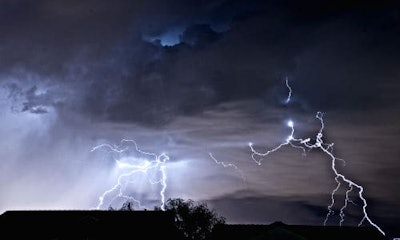
By Jeff Sanford
Toronto, Ontario — November 25, 2015 — A surprise wind storm in BC. Massive hailstorms. More intensive thunder storms. The frequency and intensity of weather events seems to be increasing. It just might be time to give the subject of extreme weather a bit of thought. It’s common knowledge that weather conditions are often responsible for driving business in the collision repair industry, so an increase in extreme weather events could result in higher repair volumes on a local level.
Last week BC Hydro suffered the worst outage in the history of the utility as gusts of wind hit the 115 km per hour mark. A truck was pushed off the road in northern BC. Earlier this summer intense hailstorms swept across Manitoba. In spring, intense thunder storms battered the East Coast and flooded Texas.
If it seems as if the frequency of once-in-one-hundred is increasing, there is new evidence that confirms your paranoia. It’s hard to deny there are a lot of extreme weather events breaking out these days. A drought in California. Thousands of forest fires in Brazil, Indonesia and Canada. The extreme weather events seem almost common now. Relatively speaking, they’re not really that extreme any more.
Is the increasingly frequency of extreme weather events having an effect on the business of repairing cars? That is impossible to say. But the anecdotal evidence is piling up. There is solid evidence, that, overall, extreme weather events are increasing in frequency.
According to a new report from the United Nations Office for Disaster Risk Reduction (UNISDR) and the Belgian-based Centre for Research on the Epidemiology of Disasters (CRED), weather-related disasters have occurred nearly every day over the past decade. This is twice the rate only two decades ago. There was an average of 335 weather-related disasters each year between 2005 and August of this year. That is up 14 percent from 1995 to 2004, twice the rate recorded between 1985 and 1994.
No wonder leaders are gathering in Paris this winter to discuss global plans to curb greenhouse gas emissions. Global warming seems to be a fact. No one wants to take pleasure in another misfortune, but this might be good for the collision repair industry.
Brent Gerrits is the owner of Brent Gerrits Collision & Refinishing in Port Williams, Nova Scotia. As an operator in a rural area, he’s probably more aware of the weather than most. “It’s hard to say if there’s been a pattern here on the East Coast,” he says. “We were up to our eyeballs, literally, in snow last year. I think there’s a move in the direction of higher frequency of severe weather. It’s not quite like the tropics, but we’ve seen a lot of variability.”
Insurance companies have actually been talking about this for years. The larger insurance companies that insure insurance companies, re-insurers, have been particularly outspoken and proactive. The executives at these companies understand the science and know that they have prepare for what’s coming. Arguably, a proactive, anticipatory stance is one that collision repair shop owners should take as well.
Should you have a plan in place for when these freak weather events happen? There are climate activists who talk about the rising amounts of methane from deep in the ocean being released. The permafrost across the north is melting. So there are feedback loops developing. As the arctic warms faster than the equator, the temperature differentials that keep the jet stream in place are breaking down. The shifts in the jet stream is creating some of these anomalies. These trends will only sharpen in the years to come. You don’t have to become a full-out prepper, bagging rice in the basement, stocking up on guns, gold and rural land, but some consideration—maybe even a written plan—for what is expected when that storm-related spike in business occurs doesn’t seem to be as crazy an idea as it used to be.






















